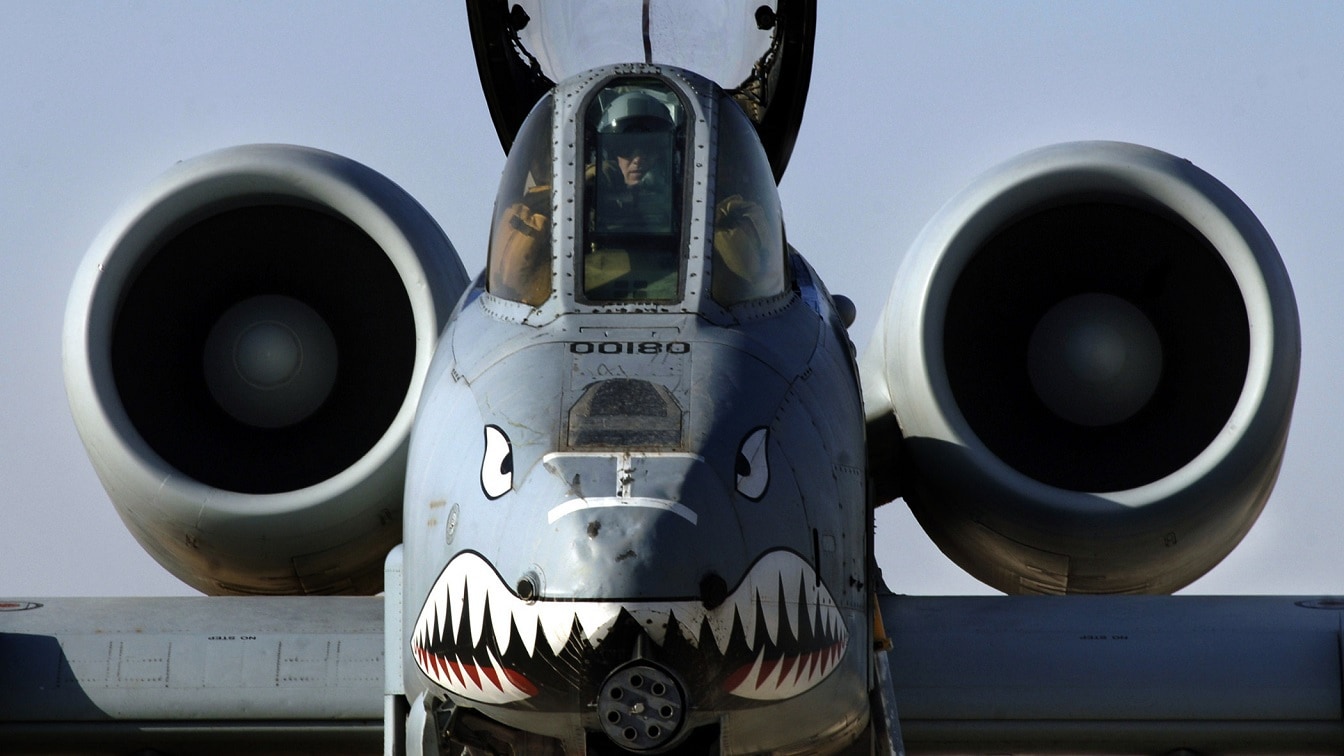The A-10 Warthog: Designed to Destroy Soviet Tanks, Forced to Gun Down Insurgents – Though the A-10 never went to war against massed Eastern Bloc armored formations, it enjoyed a new lease on life as a ground-support platform for American forces in Iraq and Afghanistan.
It now faces a problem it never saw coming: a battle to stay relevant.
The A-10 Warthog Is Decades Past Its Prime
The A-10 Thunderbolt II—known colloquially as the Warthog—was the pinnacle of Cold War-era anti-tank warfare from the air. Designed in the 1970s to take on the kinds of massed tank formations that the United States assumed they would face in Europe in the event of a Soviet attack, the A-10 was heavily armed and heavily armored.
The airframe is built around the GAU-8 Avenger rotary cannon, and the massive 30-mm Gatling gun is buried in the airframe. The A-10’s design placed a premium on overwhelming firepower, survivability, and an extended on-station loitering capacity, which cemented its role as one of the pre-eminent ground-attack aircraft of the Cold War. While the A-10’s design was validated during the United States’ involvement in Iraq and Afghanistan, the advent and proliferation of modern air defenses have significantly reduced the Warthog’s capability against a peer threat.
Built to Destroy
The A-10’s most striking feature is its 30-mm main gun, which is almost half of the airplane’s length. The GAU-8 fires depleted-uranium armor-piercing rounds in short bursts and is capable of penetrating virtually any amount of enemy armor.
In a nod to the airplane’s need for survivability in highly contested spaces, the pilot and cockpit are surrounded by titanium armor plating, a kind of bulletproof bathtub. This, combined with redundant flight controls and a reinforced airframe, allows the airplane to shrug off a significant amount of damage and return to base.
Another point of interest is the A-10’s two engines, which are placed high up on the fuselage. These help to avoid foreign object ingestion when landing on ersatz landing strips, and they offer a slight amount of protection from ground fire.
During the Cold War
If the Cold War had ever turned hot, A-10s would have been arrayed in large numbers to buffer Soviet armored advances into West Germany and elsewhere on the continent. In tandem with NATO allies, A-10s would have used their GAU-8 main gun, unguided ordnance, cluster munitions, and air-to-ground weaponry to strike Eastern Bloc tanks, infantry fighting vehicles, armored personnel carriers, and other vehicles.
But the Warthog would have struggled against dedicated air defenses and other fighter aircraft, particularly stealth jets.
Combat History in Iraq and Afghanistan
The lion’s share of A-10 combat history is in the Middle East, as part of the United States’ operations in Afghanistan and Iraq, as well as during the Gulf War in 1991, when A-10s destroyed hundreds of Iraqi tanks and other vehicles.
During the war on terror, the A-10 was a crucial part of the United States’ close-air-support operations in Iraq and Afghanistan. The Warthog’s ability to fly at low speeds and low altitudes for extended periods made it quite valuable to troops on the ground struggling to engage enemy forces in mountainous or otherwise rugged terrain.
Part of the A-10’s success, however, was due to the overwhelming air dominance enjoyed by American and coalition forces. Complete air superiority meant that the A-10 was never really at risk from enemy forces.
The A-10 and the War in Ukraine
Though Ukraine now operates the F-16 fighting Falcon as well as small numbers of other Western fighter jets, Kyiv has not made a concerted effort to acquire American A-10s—despite the apparent need for potent anti-armor capabilities. They have not requested it specifically because, in a highly contested environment, the jet would struggle mightily to survive. And right now, there is no other aerial environment in the world that is as contested as the skies along the front in Ukraine.
A-10s would make easy targets for Russian surface-to-air missile batteries, and other surface-to-air weaponry. American-supplied Warthogs would prove very vulnerable. In addition, adding another jet platform to the mix—one that Ukraine would not only have to maintain, but train other pilots and maintainers to work with—would be a significant logistical complication. It would not be justified, especially considering the A-10’s low survivability against a concerted Russian air-defense threat.
Most recently, however, a number of Warthogs had been scrambled from Idaho to the Middle East as part of the ongoing buildup of forces there, seemingly arrayed against the regime in Iran and their proxy, the Houthis in Yemen.
A-10 Warthog and Fathertime
The A-10 Warthog is arguably the pinnacle of anti-tank, ground-attack aircraft from the Cold War era. And while it never did take on the kinds of massed Eastern Bloc armored formations it was designed to attack, the jet’s success as a ground-support platform for the United States’ counterinsurgency operations in Iraq and Afghanistan validated the jet’s design.
Fast-forward to today, however, and against a peer adversary with modern air defenses, the A-10 would face slim odds of survival. Though it could perhaps find a role as a niche ground-support aircraft in environments where the skies are uncontested, the Warthog’s future usefulness is dubious at best.
Still, had the Soviet Union launched a ground offensive during the 1970s or afterward, the A-10 would have posed a significant threat to Soviet armor.
About the Author: Caleb Larson
Caleb Larson is an American multiformat journalist based in Berlin, Germany. His work covers the intersection of conflict and society, focusing on American foreign policy and European security. He has reported from Germany, Russia, and the United States. Most recently, he covered the war in Ukraine, reporting extensively on the war’s shifting battle lines from Donbas and writing on the war’s civilian and humanitarian toll. Previously, he worked as a Defense Reporter for POLITICO Europe. You can follow his latest work on X.

